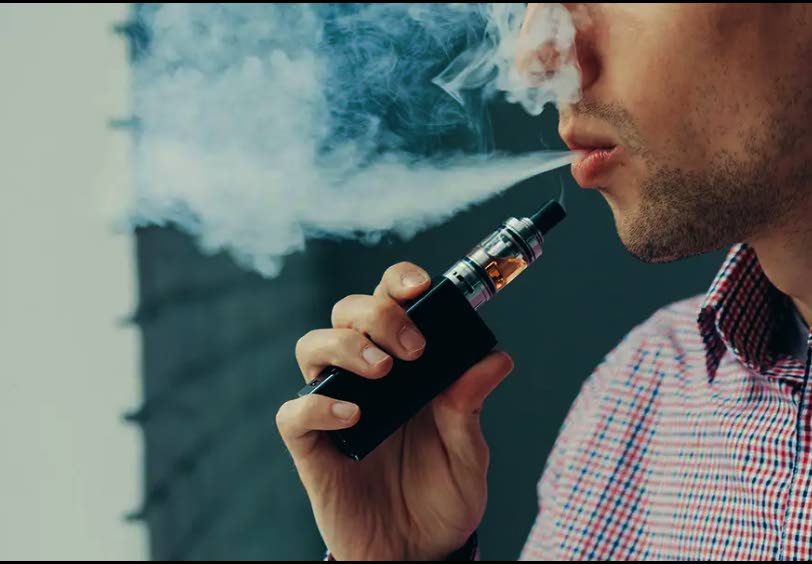Vaping – the dangers to your health

VAPING is when you use a hand-held electronic device to breathe a mist (“vapour”) into your lungs. An e-cigarette, pave pen or other electronic nicotine delivery system (ENDS) heats a liquid of nicotine, flavouring, propylene glycol and other additives into an aerosol that you inhale through a mouthpiece.
It’s similar to smoking a cigarette, but vaping heats tiny particles out of a liquid rather than burning tobacco. Vaping can cause breathing problems, organ damage, addiction and other conditions.
Vaping works by heating liquid in a small device so you can breathe it into your lungs. The e-cigarette, vape pen or other vaping device heats the liquid in the device to create an aerosol. This isn’t water vapour. Mist from e-cigarettes contains particles of nicotine, flavouring and other substances suspended in air. You breathe these particles into your mouth from the mouthpiece, where they go down your throat and into your lungs.
Vaping devices
An electronic cigarette or vaping device is a device that heats up the liquid nicotine and flavouring for you to breathe in. There are many varieties and they go by different names, including vapes, vape pens or sticks, e-hookahs, hookah sticks, mods and personal vaporizers (PVs). They can also be collectively called electronic nicotine delivery systems (ENDS).
Most types of e-cigarettes have:
· A cartridge, tank or pod that holds liquid (can be refillable).
· A heating element for turning the liquid into breathable particles (aerosol, commonly called “vapour”).
· A battery to power the heating element.
· A power or control button (some are activated by sensors when you inhale).
· A mouthpiece to breathe in the aerosol.
Vaping and smoking both involve inhaling nicotine and other substances into your lungs. E-cigarettes heat liquid to make an aerosol; cigarettes burn tobacco, which creates smoke.

Vaping is often thought of as safer than cigarette smoking, but vaping causes health problems, too. Both vaping and smoking are addictive and bring potentially dangerous chemicals into your body.
The levels of many of these chemicals is higher when you burn tobacco. Vaping hasn’t been around long enough to know what kind of long-term damage it might cause.
Damage to lungs
The particles you inhale while vaping can cause inflammation (swelling) and irritation in your lungs. This can lead to lung damage like scarring and narrowing of the tubes that bring air in and out of your lungs. Vaping doesn’t make water vapour. It actually creates an aerosol (or mist) that contains small particles of nicotine, metal and other harmful substances.
What is e-juice
E-liquid, also called e-juice or vape juice, is what vaping devices use to make the vapour you breathe in. They usually contain:
· Flavouring. Each flavouring has its own set of ingredients.
· Nicotine, the addictive and harmful substance in cigarettes and other tobacco products.
· Propylene glycol and glycerine, used to create vapour.
Additionally, e-liquids and flavourings sometimes have other ingredients, including:
· Chemicals that can cause cancer (carcinogens), like acetaldehyde and formaldehyde.
· Chemicals known to cause lung disease, such as acrolein, diacetyl and diethylene glycol.
· THC (tetrahydrocannabinol), the chemical in marijuana that gets you “high.”
· Vitamin E acetate, linked to lung injury caused by vaping.
· Heavy metals like nickel, tin, lead and cadmium.
· Tiny (ultrafine) particles that can get deep into your lungs.
Dangers of vaping.
Problems vaping causes include:
- Asthma. Vaping can make you more likely to get asthma and other lung conditions. It can make your existing asthma worse.
-Lung scarring. Diacetyl, a chemical used in some flavourings, can cause bronchiolitis obliterans (“popcorn lung”). Bronchiolitis obliterans causes permanent scarring in your lungs.
- Organ damage. In addition to your lungs, nicotine and other substances in e-liquid can hurt your heart and brain. We know nicotine can hurt brain development, raise your blood pressure and narrow your arteries.
- EVALI (e-cigarette, or vaping, product use associated lung injury). EVALI is a serious lung condition that vaping causes. It causes widespread damage to your lungs and gives you symptoms like coughing, shortness of breath and chest pain. EVALI can be fatal.
- Addiction. Nicotine is highly addictive. It causes changes in your brain so you want more and more nicotine. You might not be able to stop vaping if you want to or if it starts causing health problems. Even e-liquids that say they’re nicotine free have small amounts of nicotine.
- Cigarette smoking. Many people start out vaping and end up smoking cigarettes, which contain higher amounts of harmful chemicals.
- Second-hand exposure. Vaping doesn’t make smoke, but people around you are exposed to nicotine and other chemicals when you vape.
- Explosions. There have been incidents of batteries in vaping devices exploding and causing serious injuries and burns.
- Cancer. Some ingredients in e-liquids are known to cause cancer.
EVALI – a dangerous vaping risk.
EVALI is short for e-cigarette, or vaping, product use associated lung injury. It’s a serious lung condition caused by vaping. Vitamin E acetate, found in some e-liquids, is a possible cause.
An outbreak of EVALI in late 2019 and early 2020 put thousands of people in the hospital. At least 68 people died. Since then, EVALI cases have been declining, but people who vape can still get EVALI.
Among people who were hospitalized with severe EVALI, most were younger than 35 and used THC-containing vapes from informal sources (online, family or friends). However, EVALI can happen in anyone using either nicotine or THC-containing vapes.
Symptoms of EVALI include: Cough, shortness of breath, chest pain fever, vomiting, diarrhoea, stomach pain fast heartbeat.
Vaping side effects
Short-term side effects of vaping include:
- Coughing.
- Shortness of breath.
- Eye irritation.
- Headaches.
- Dry and irritated mouth and throat.
- Nausea.
Some damage to your lungs from vaping can heal or get better with medications. Others, like lung scarring, are permanent. Over time, constant irritation to your lungs can lead to health problems such as asthma. In some cases, you can die from lung injuries vaping causes.
For women who vape, vaping while you are pregnant exposes you to some of the same chemicals that cigarette smoking does. Vaping while pregnant can cause low birth weight, lung damage and brain damage in the developing foetus.
Vaping isn’t approved as a way to quit smoking. Approved methods include patches, inhalers, lozenges and gum. While vaping might help you quit smoking, it probably won’t help you quit nicotine altogether.
In a recent study, about 18 per cent of people who switched to vaping had been able to quit smoking. That’s about twice as many people as those who used other methods to quit smoking.
However, about 80 per cent of people who quit smoking were still vaping. Of people who used other methods, 91 per cent kicked nicotine products altogether.
From accessories to flavours, vaping can seem very appealing.
Unfortunately, it’s not as harmless as it seems. We know nicotine and other ingredients in e-liquids can hurt your body and we still don’t know what long-term health problems vaping could cause. If you don’t vape, don’t start. If you need help quitting, seek help from your doctor.
Dr Maxwell can be reached at: 363-1807 or 757-5411.


Comments
"Vaping – the dangers to your health"